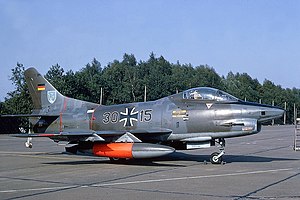NBMR-1
| NBMR-1 | |
|---|---|
 |
|
| The winning entry, Fiat G.91 lightweight strike fighter | |
| Project for | Development of military aircraft |
| Issued by | NATO |
| Date initiated | 1953 |
| Prototypes |
Breguet Taon Br.1001 Dassault Mystère XXVI Fiat G.91 |
| Date concluded | 1958 |
| Outcome | G.91 officially declared winner |
| Successor programs | NBMR-3 |
NATO Basic Military Requirement 1 (NBMR-1) was a document produced by a North Atlantic Treaty Organisation (NATO) committee in the 1950s detailing the specification of future combat aircraft designs. The requirement was for a "light weight tactical strike fighter (LWTSF)" capable of carrying both conventional or tactical nuclear weapon from rough airfields and have simple maintenance requirements.
In December 1953, NATO Supreme Command, realizing that a few, expensive and complex fighters located on few airbases were very vulnerable in case of a nuclear war, issued a specification for a new light tactical support aircraft. Aircraft manufacturers within NATO countries were invited to submit their designs for a Light Weight Strike Fighter. The competition was intended to produce a combat aircraft that was light, small and equipped with basic weapons and avionics. It should also be able to operate from dispersed airfields and require minimal ground support.
The technical requirements were:
The challenge of providing an engine that matched the requirements of lightness and power, reliability and ease of maintenance was solved by using the Bristol Siddeley Orpheus turbojet. The development of the Orpheus was funded from the US Mutual Weapons Development Program which was a way for the US to support weapons procurement for members of the NATO alliance.
Designs were submitted by manufacturers from many NATO countries, including France, Italy and the United States. Designs were required within two months of the competition and submitted to AGARD under the leadership of Theodore von Kármán. The committee assessed eight projects, including the Aerfer Sagittario 2 (Italy), Breguet Br.1001 Taon (France), Dassault Mystère XXVI (France), Fiat G.91 (Italy), Northrop N-156 (USA) and Sud-Est Baroudeur (France). Although its development is considered a factor which motivated NATO to issue the requirement, the Folland Gnat itself was not evaluated in the competition.
...
Wikipedia
